HR Employee Personas

Employee Personas - the key to understanding your staff and to attract new high-potential talent.
The importance of HR personas
An organization can expect 250 resumes for a corporate job offer on average. Only 4-6 will be invited for an interview, and one will get the job. (Glassdoor)
Furthermore, the typical cost per hire is around 4,000 USD. (SmartRecruiters) These are clear indicators of how time-consuming and costly this process can be.
As a recruiter, your ultimate goal is to find the perfect candidate, which sometimes is a huge challenge. 80% of high-potential candidates are not actively looking for a job. This means you have to find them and target them specifically.
To understand them profoundly, you need to create employee personas.
HR personas allow you to streamline the efforts for attracting new staff members. The strategy is built around the employee needs so the team has an exact focus point and guidance in every recruitment process stage.
If you prefer watching rather than reading, check out our Youtube Series on HR Personas.
What is an employee persona?
An employee persona represents an employee cluster with similar needs, characteristics, hobbies, interests, and behaviors. They should be based on real data rather than assumptions to secure accurate information and avoid human bias.
You need to map the job requirements with the candidate's skills and understand their drivers, language, needs, and motivations. Employee personas will help you make decisions about where to target them, how to approach and talk to them, and how to present your company -whether writing the job description, looking for them on platforms, or placing ads in the right outlets.
How to create an employee persona
In general, a persona should be based purely on data rather than assumptions. The usage of quantitative and, more importantly, qualitative data analyses to avoid any human bias and identify the most essential and promising clusters. Organizations can tap into internal and external data sources to detect valuable data. Internal employee research (conducting interviews and surveys) will help you understand your existing workforce and set future staff parameters.
Equally important is the analysis of publicly available data. When you base the personas on internal data only, you risk including blind spots and biases, which should always be avoided. Listen carefully to what people say about your brand or product, or the company's given position, to understand what information is most relevant. An objective analysis is the basis for the success of your personas.
Avoiding Bias in HR Persona Creation
As just mentioned, biases are probably the biggest hurdle for persona creation to make sure they are purely grounded in data rather than gut feelings and assumptions. Let us investigate how to tackle biases for HR persona creation.
Audit Existing Personas for Unintended Bias
If your company has existing employee personas, review them with a critical eye to check for unintended biases. Do certain personas disproportionately reflect a single gender, ethnicity, or educational background? Are there unspoken expectations that may limit opportunities for diverse candidates? Conducting an internal bias audit can help refine personas to be more inclusive.
Include Diverse Voices in Persona Development
To avoid unconscious bias, involve a diverse group of stakeholders in persona creation. This could include employees from different backgrounds, DEI specialists, and external consultants who can provide perspectives HR teams may overlook. Conducting focus groups with employees from underrepresented backgrounds can also offer valuable insights into their experiences and needs.
Beware of Cultural and Socioeconomic Bias
Employee personas should not assume that all candidates have access to the same resources and opportunities. For example, requiring candidates to have an elite university background or specific unpaid internship experiences can unintentionally exclude talented individuals from different socioeconomic backgrounds. Instead, focus on skills, experiences, and potential rather than overly rigid criteria.
Test Personas with Real-World Scenarios
Once personas are developed, test them in real-world hiring and retention strategies. Are they leading to a more diverse talent pool? Are certain personas unintentionally limiting inclusivity? Gathering feedback from HR teams, hiring managers, and employees can help refine personas to better reflect a truly diverse workforce.
Regularly Update Personas to Reflect a Changing Workforce
Workforce demographics and inclusion best practices evolve over time. A persona created today may not accurately reflect employee needs five years from now. Regularly revisiting and updating personas ensures they stay relevant and continue to support a diverse, equitable, and inclusive workplace.
If you want to learn more about the persona generation process, check out our series on Persona Creation with AI.
Persona Components and Insights for HR
Let us take a look at a sample HR persona and investigate the different components and how they can be used for HR itself as well as marketing.
Demographics
Alright, let's pretend you're an HR company looking to attract someone like this System Specialist-a 38-year-old, married professional living in Raleigh, NC, with a solid $110K salary. Here's how you can use HR personas to find and market to them effectively.
Finding New Candidates Like This System Specialist
- Leverage Data-Driven Job Boards & Platforms
Given their experience and salary, they're likely not scrolling through Indeed looking for entry-level jobs. Instead, focus on: - LinkedIn Recruiter Search - Target profiles with similar job titles, skills, and location.
- Niche Tech Job Boards - Sites like Dice, Stack Overflow Jobs, or We Work Remotely may be better than generalist platforms.
- Industry-Specific Meetups - Check out Raleigh-based IT and networking events.
- Engage in Industry-Specific Communities - This candidate may frequent forums like GitHub, Reddit's r/sysadmin, or tech Slack groups. Engage in discussions before pitching a job.
Marketing to This Persona
Once you've identified potential candidates, your messaging needs to feel personal and aligned with their values and motivations.
Let's break it down:
- Speak Their Language in Job Descriptions & Ads
Highlight Career Growth - At 38, this person is mid-career. They don't want another “job”-they want career progression. - Your job postings should emphasize:
Leadership opportunities
Certifications/training support
Challenging projects that make an impact - Avoid Generic Buzzwords - Instead of saying “Looking for a self-starter in a fast-paced environment,” say something like: “We're looking for a System Specialist who enjoys solving complex technical problems and shaping scalable IT solutions for a growing enterprise.”
- Leverage Locality - If hiring locally, highlight community aspects: “Join a team of top IT professionals in Raleigh and be part of a growing tech community.” If hiring remotely, emphasize why your company supports remote work well: “Work from anywhere while staying connected with a top-tier It team.”
Needs & Go tos
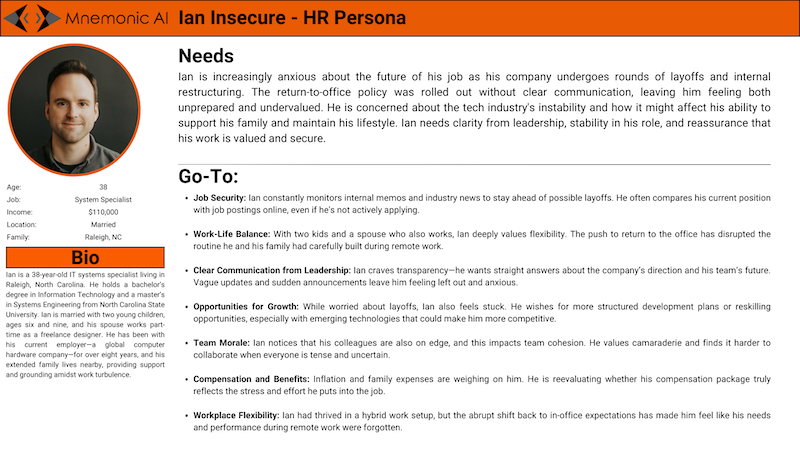
Ian is a mid-career IT professional feeling unstable in his role due to layoffs, unclear leadership communication, and shifting work policies. He isn't actively job-seeking but is monitoring opportunities for job security, stability, and flexibility. To attract someone like Ian, HR firms must address his career anxieties, desire for transparency, and need for work-life balance.
Addressing Needs & Go tos
To convert Ian into an applicant, messaging must be focused on job security, leadership transparency, and flexible work policies.
- Speak to Job Security & Stability in Job Description.
- Ian is not looking for a job-he's looking for stability. Instead of generic “fast-paced environment” language, use: “Join a stable, growing IT team where leadership prioritizes clear communication, long-term career development, and job security.”
- Highlight the financial health of the company (funding, profitability, employee retention rates).
- Address Work-Life Balance & Flexibility in Recruitment Outreach
- Ian values family time and the flexibility of remote work. Outreach should reflect that: “We understand the importance of work-life balance. Our hybrid model allows flexibility while keeping collaboration at the core.”
- Showcase employee testimonials about how the company supports working parents.
- Provide Transparency & Leadership Communication in Employer Branding
- Since Ian is frustrated with vague leadership updates, HR firms should position client companies as transparent, employee-focused employers:
- Share thought leadership from executives on job stability.
- Publish Q&A sessions or town hall recaps to showcase an open leadership culture.
- Since Ian is frustrated with vague leadership updates, HR firms should position client companies as transparent, employee-focused employers:
- Emphasize Career Growth & Upskilling
- Ian feels stuck in his role and wants growth opportunities.
- Marketing content should highlight:
- Paid certifications (AWS, cybersecurity, etc.)
- Defined career tracks and mentorship programs
- Internal mobility success stories
- Competitive Compensation & Benefits Messaging
- Ian is reassessing his salary due to inflation and stress levels. Ads should highlight above-market pay, strong healthcare benefits, and family perks: “Competitive salaries, inflation-adjusted raises, and benefits that support your family's future.”
Representation and Candidate Cluster Size
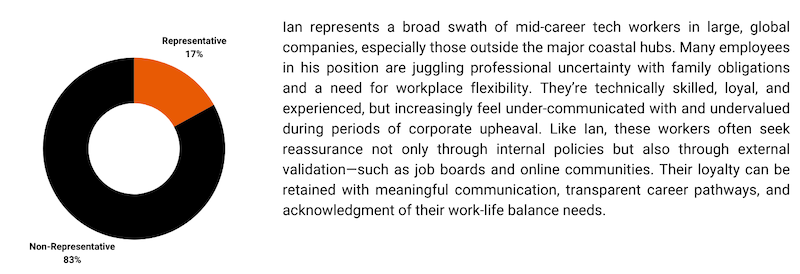
Understanding that Ian's persona represents the largest candidate cluster (17%) allows HR teams to optimize their processes.
Since 17% of potential candidates belong to Ian's segment, HR can strategically allocate more resources-including advertising budgets, recruiter time, and employer branding efforts-toward channels and strategies that resonate most with this group.
Rather than spreading marketing efforts across all personas, focusing on high-impact platforms like LinkedIn, YouTube, and Reddit ensures that recruitment messages reach the right audience.
Additionally, job board investments should be prioritized on sites where this talent pool frequently searches for opportunities or stays informed about industry trends. By refining budget allocation in this way, HR can maximize recruitment efficiency, improve candidate engagement, and ensure a higher return on investment.
Using Candidate Personality Analyses for HR
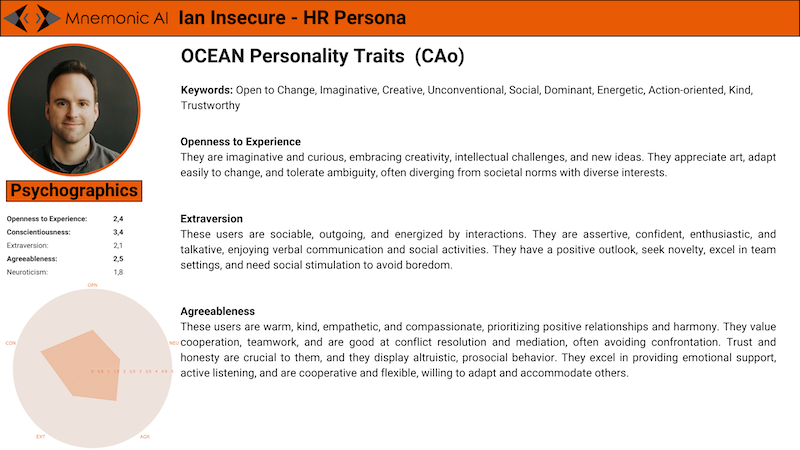
Understanding personality traits through models like the Big Five (OCEAN) opens up a more nuanced, psychological layer to HR marketing. The Big Five Personality Traits, often referred to by the acronym OCEAN-Openness, Conscientiousness, Extraversion, Agreeableness, and Neuroticism-offer a powerful framework for understanding individual behavior in the workplace. Widely recognized in psychology and organizational research, the OCEAN model provides HR professionals with a data-driven tool for evaluating candidates, shaping team dynamics, and crafting more personalized and effective talent strategies.
Instead of segmenting potential candidates only by age, job title, or location, HR teams can now design recruitment strategies based on how people process information, respond emotionally, and make decisions. This allows for smarter, more human-centered messaging that meets candidates where they are-mentally and emotionally.
In recruitment, OCEAN analysis helps assess soft skills such as adaptability, teamwork, emotional regulation, and communication style-factors that traditional resumes and interviews often overlook. By using personality data, HR teams can better predict how a candidate will perform in specific roles, collaborate within different team constellations, and align with company culture.
Beyond hiring, the insights gained from OCEAN profiles are incredibly valuable for candidate engagement and employer branding. Understanding personality traits can inform how companies communicate with different talent segments, from messaging tone to the platforms they prefer. Ultimately, integrating the Big Five personality analysis into HR processes allows companies to hire smarter, build stronger teams, and reach talent with more precision and empathy.
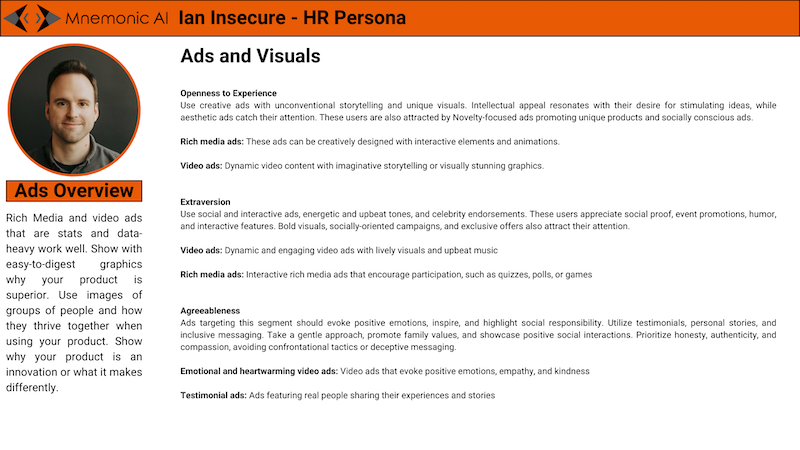
Take, for example, how candidates differ in how they engage with content. The candidates presented by persona Ian, are dominant in the Openess to Experience trait. These candidates are naturally curious, imaginative, and drawn to new ideas and unconventional thinking. For this group, traditional job ads won't cut through. What captures their attention are creative campaigns-rich in storytelling, visually striking, and often tied to meaningful causes. These candidates want to work somewhere that challenges norms, embraces innovation, and aligns with their values. By crafting ads with visually rich formats, interactive design, or thought-provoking messages, HR can directly connect with these high-openness individuals.
Others, however, are energized by interaction. They seek connection, conversation, and a sense of shared experience. For these extraverted personalities, recruitment campaigns should be lively and social. Formats like video ads with upbeat music, interactive quizzes, polls, or even live events tap into their need for engagement and make the employer brand feel more dynamic and approachable. They aren't just looking for a job-they're looking for a team, a culture, a vibe they can belong to.
There are also candidates whose decisions are driven by empathy, community, and harmony. These individuals respond best to warmth, authenticity, and emotional honesty. For them, the most persuasive content isn't flashy-it's personal. Heartfelt video testimonials, stories of inclusive team culture, or messages that show the human side of leadership help build a deep sense of trust. This group wants to know they'll be supported, heard, and valued in their next role-and the tone and substance of your message must reflect that.
Communication
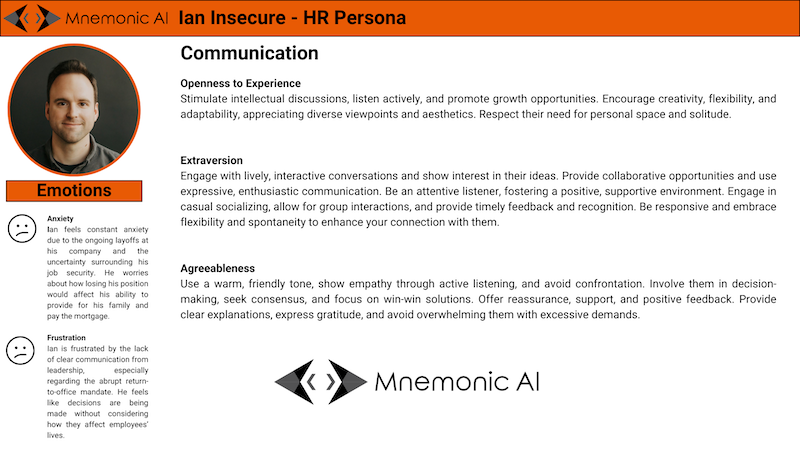
When applied to interpersonal interactions-whether in recruitment, team management, or employee development-the Big Five personality traits offer HR professionals a powerful framework for understanding how to connect with people on a deeper, more respectful level. Instead of treating every candidate or employee the same way, HR can tailor communication styles, engagement strategies, and workplace experiences to align with each person's core behavioral tendencies.
For individuals high in Openness to Experience, it's important to create space for intellectual curiosity and creative expression. These individuals are stimulated by deep discussions, new perspectives, and environments that embrace change and diversity. In the hiring or onboarding process, HR professionals should encourage conversations that explore ideas and personal growth. Give them room to reflect, respect their need for autonomy, and highlight how your organization supports continuous learning and exploration. This builds trust and signals that their originality will be valued.
When engaging with Extraverted individuals, energy and responsiveness go a long way. These are people who thrive on social interaction, group collaboration, and lively communication. HR teams can better connect with them through enthusiastic dialogue, informal check-ins, and opportunities for them to share and contribute in real time. They appreciate visibility, recognition, and immediate feedback-so interactions should feel dynamic and two-way. Whether it's during interviews or daily team interactions, making room for spontaneous conversation and celebrating quick wins can strengthen their sense of belonging.
On the other hand, Agreeable personalities flourish in environments defined by empathy, cooperation, and mutual respect. These individuals seek harmony and are highly attuned to the emotional tone of interactions. HR professionals should approach them with genuine kindness, careful listening, and a collaborative spirit. Rather than pushing decisions top-down, involve them in shaping outcomes. Offer reassurance during transitions, acknowledge their contributions, and ensure communication is gentle and transparent. Avoid high-pressure tactics or combative debates- they respond far better to positivity and inclusion.
Overall, aligning interpersonal strategies with personality traits enhances not only recruitment success but also employee satisfaction, retention, and team cohesion. It moves HR beyond transactional tasks and into the realm of strategic human connection, where every conversation becomes an opportunity to build trust, motivation, and a more emotionally intelligent workplace.
The effect of personas on HR challenges
Let us look at different HR challenges and how your employee persona can assist you.
Internal recruiting costs
Employee personas could give you an idea of what referral bonuses (cash or prizes) are more attractive to potential candidate clusters and help you adjust them accordingly. Also, the interview costs are reduced by only attracting candidates who are likely to be a good fit and are mapped to the personas.
External recruiting costs
A significant cost factor for HR is advertising (PPC, Job Boards, etc.) to attract the right candidates. The better the understanding of your ideal candidate, the easier it will be to target them. Keywords in recruitment are incredibly competitive, and therefore, the more defined the candidate profile is, the easier the targeting will be. But even if you reach the right candidates, you need to provide the correct language and message to get their attention, which is easier when you have the personas in front of you. Since the team that places the ads is often not the HR team but the marketing team, it is even more critical to provide them with a clear picture of the candidates to be targeted.
Also, if you work with external recruiters or agencies, providing them with the personas will make it easier for them to track them down, thereby saving time, money, and effort.
Social Media activity
Since 80% of A-level talents are not actively looking for a job, building a compelling social media presence is crucial to get their attention. Tweeting, posting, advertising the message “come work for us” is not gone to the cut. You need to analyze and understand the different personas and tailor your activity and message to focus on career drivers, frustrations about their current employers or management, personal interests, values, or culture.
Persona-based Job descriptions
The job description needs to be written in the same language the employee persona speaks and interacts with-the better the mapping, the bigger the empathy towards the job and the company. Listing the required skills and education is not enough to attract A-level candidates. Instead, it needs to tell a compelling story on how the job matches the persona's desires and needs. Always remember, it is personalization that builds empathy.
Corporate Influencers
Influencer Marketing itself is nothing new, but actively building corporate influencers is. Identifying employees that can help spread the word about your company and communicate values and vision can be a powerful tool to attract new employees and customers. HR needs to work closely with the marketing team and have employee personas in place to help everyone involved in making the right decisions.
Career Website
Like your ads, the career website and job description should address the employee personas' exact needs, wants, and pain points. Move away from talking about a generic vision or values. Focus on how the company can provide the foundation for realizing their goals, conquering their frustrations, and helping with their needs.
Customer Centricity
The same concept behind customer-centricity, which involves building offers, communication, and other elements around individual customer clusters, should also be applied to your HR strategy. If you have identified multiple employee personas, you should have unique plans in place accordingly. Creating different landing pages, the same way marketers do for other clients, is key. It allows you to focus on what is most important to a particular employee cluster. Since there are numerous leadership styles, highlighting what you expect and what you do not want will narrow down the pool of potential employees and, therefore, decrease the screening work for you.
Summing up, if you're still relying on gut instinct and generic job ads to attract talent, you're already falling behind.
Employee personas aren't a “nice-to-have.” They're your secret weapon.
They cut through the noise, lower recruiting costs, and connect you with the right people faster, smarter, and more human.
Stop guessing. Start understanding.
This is HR, leveled up.
